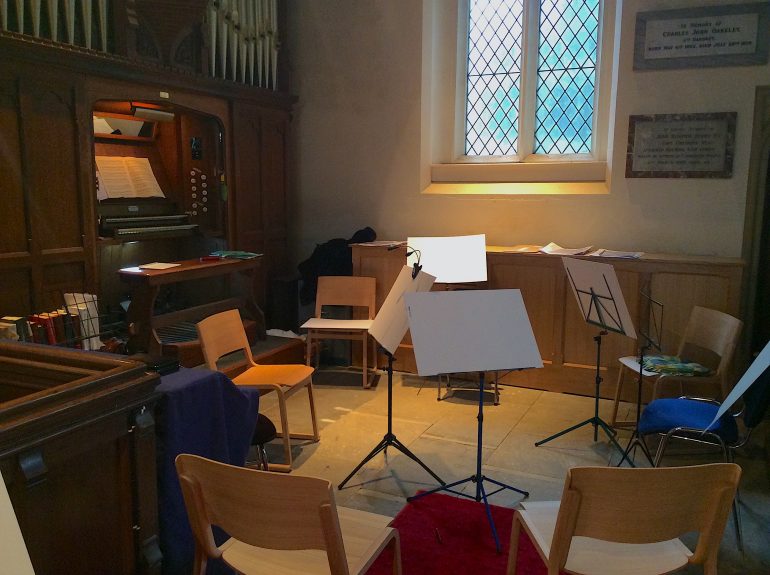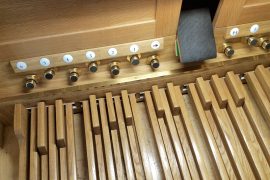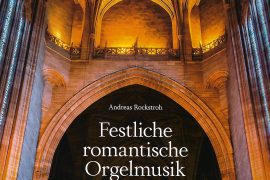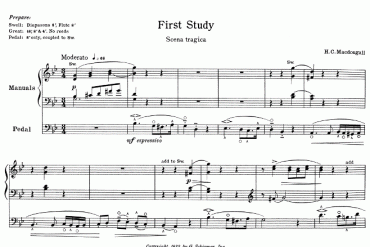I have always wanted to play the Handel organ concertos, ever since my teens, when I was given an LP of a no doubt very unhistorically-informed set of performances. Appointed Director of Music here in Frittenden, surely a little grandeur could be allowed, and I could organise a small orchestra for a play-through of my favourites?
For many years I worked in orchestral and concert management in London, so this post is by way of sharing my experience of working with orchestral musicians, if you want to try this yourself. If you’re used to playing with ensembles, then you might want to skip to the repertoire suggestions and downloads at the end. But we organists do get used to playing on our own, and dare I say it, can grow a bit sloppy and idiosyncratic. Playing with an orchestral ensemble is a good discipline for us – rather more demanding that working with singers. While a choir will, hopefully, listen to the organ and slot into its sound, orchestral musicians concentrate on delivering their own set of dots, and woe betide you if you pause for breath or indulge an impromptu rubato – you just get left behind.
Finding your orchestra
Approach early music networks, local semi-pro orchestras, quartets, school groups, local string teachers. You can achieve a lot with just half a dozen string players – say four violins (two firsts, two seconds) and a viola and a cello, though more is obviously better. Call it a workshop, which has an air of learning and experimentation about it, rather than the expectation of perfect performances.
Orchestral management
If you haven’t encountered orchestral musicians, you need to know they are slightly different beasts to organists. Organists get used to fending for themselves: string players operate in flocks, and they’re used to having life organised for them by the management. So unless this is just an informal get-together of friends and friends-of-friends, professional organisation of the day is important. I’m assuming that the event will be taking place in your church, so:
- Make a rehearsal plan of some kind, with timings.
- Three hour rehearsal sessions (three and a half hours maximum) are customary, with a 20 minute break for coffee and rest rooms approximately half way through.
- Organise the rehearsal so no-one is sitting around for too long with nothing to do (the violas may have to be given their own coffee break at some point).
- Tuning – most orchestral musicians are prepared to tune down a bit to a particular organ, especially if they are early music specialists, but it’s good manners to let them know in advance that the organ is tuned A435, for example, in case anyone seriously objects.
- Check out in advance that you have enough appropriate chairs available, that the lighting is adequate for them, not just you (you may have to invest in some of those battery-powered clip-on stand lights), and that you have enough music stands to go round (though if you ask in advance, most musicians are happy to bring their own).
- Go through in your mind all the issues around parking, heating, loos, and tea and coffee.
- Your church may want a Health & Safety Assessment for the event, and remember Safeguarding if anyone coming to play is under 18.
- You may think this is labouring it a bit, but put all these details, plus repertoire, timings, postcodes, and phone numbers on a sheet and email it to the players beforehand. It’s professional and makes people feel they’re in good hands, and saves wasted playing time on the day.
Practice and preparation
- Go for easier pieces, particularly first time round: nothing more embarrassing than getting left behind.
- LEARN YOUR PART WELL BEFOREHAND, possibly with a metronome, especially if it’s demanding. There will be a lot of distractions on the day to do with running the event and responding to your fellow players, and you don’t need the added stress of struggling to stay on top of your own music.
- The more players you have, the more important it is to have someone running the rehearsal, and making decisions, in the absence of a conductor. As it’s your day, it’s perfectly in order for you to take that role, but it’s good etiquette to work with the lead violin in the first instance, who can then discuss issues of bowing and so on with other string players.
- Your players will not be used to the rather relentless sound of our instrument: rehearse on a soft 8 or 8+4 not to wear them out, and save full organ until the final run.
What music to play
There is LOADS of music for organ and modest orchestral ensemble: where you are doing a bit more than trundling along on continuo, but not challenging yourself with the likes of the Poulenc or Saint-Saens.
Most is baroque or early classical, and as we know, instruments in those periods were fairly interchangable. So unless the music is too idiomatic, you can happily substitute violin for flute, cello for bassoon, and so on. Organ can substitute for cembalo/harpsichord obviously, and close inspection of the score may well reveal you can dispense with double bass or wind parts that are just doubling someone else. For your workshop, pick and choose the best movements for variety – no need to play everything from start to finish.
IMSLP is your absolute first port of call for all this out-of-copyright music. Increasingly you can find orchestral parts there as well as the full score for any individual piece of music, but let me introduce you to Partifi, a tool to make your own orchestral parts from a full score. It’s free, and was created by musicians to support the study and performance of historical music. Like any music software, it requires a bit of patience and practice to get the best out of it, and the results are not always elegant, but they are playable, and that’s all that matters. I’ve included some of my versions for you to download (link at the bottom of this page ).
Please share with us any sets you create yourself!
RESOURCES AND DOWNLOADS
If you get no further with this project, at least take a look at this terrific listing of organ plus orchestra music put together by Michael Barone of Pipedreams, a national weekly radio programme about the organ in the USA:
Possible repertoire:
Mozart Epistle Sonatas (or Church Sonatas)
There are 17 of these charming pieces, each only a few minutes long even with repeats. A few of them add horns, trumpets, woodwind and timpani into the score, but many are just scored for organ, two violins, and cello.
Scores and parts available for many of them here on IMSLP
Other scores and parts on my DOWNLOADS page.
Also published by Barenreiter in several volumes.
Handel Organ Concertos Op 4, and Op 7
Twelve Organ Concertos in total: you can find scores and parts from IMSLP here and here. However I love these so much I decided to buy a proper printed score and parts of my favourite, Op 4 No 2 from Barenreiter.
Albinoni/Giazotto Adagio in Sol minore per archi e organo
The ‘Albinoni’ Adagio was actually written by Remo Giazotto, who died in 1998, so this work is still in copyright. I bought a score and parts from Ricordi, but I can’t find it listed online anymore. I thought this would be an obvious choice, but actually, it was the least successful on our tryout. It really needed a conductor to hold it together, so we gave up and moved on.
More possibilities from IMSLP:
Michel Corrette, Organ Concerto in G major (with solo violin)
Johann Georg Albrechtsberger, Organ Concerto in B flat major
CPE Bach, Concerto per Organo in Sol maggiore
Joseph Haydn, Keyboard Concerto in C major Hob.XVII:1
This has trumpets and oboes in the outer movements, but the middle movement is strings+organ only.
Now go to my DOWNLOADS page where you can find more organ plus orchestra to download, including the orchestral parts I created with Partifi.






Good to have you back, Morwenna. I’ll never aspire to any of this but it still makes great reading.
Thank you Gordon – I particularly enjoyed writing this!
Splendid article, which originally went to my junk folder [it won’t happen again!]. Can I make a particular plea for the Haydn Concerto in C [Hob. XVIII:1] which is really lovely and available on IMSLP. The late Jane Parker Smith made a lovely 2LP set of this sort of material which, as far as I know, hasn’t surfaced on CD – pity. [The LPs are HMV SLS 5164].
Great, thanks for that suggestion Stuart. I’ve added it to the list above. It includes trumpets and oboes, but only in the outer movements, so you could enjoy the middle movement if you only have strings.